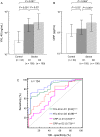Serum YKL-40 levels correlate with infarct volume, stroke severity, and functional outcome in acute ischemic stroke patients
- PMID: 23272150
- PMCID: PMC3522716
- DOI: 10.1371/journal.pone.0051722
Serum YKL-40 levels correlate with infarct volume, stroke severity, and functional outcome in acute ischemic stroke patients
Abstract
Background and purpose: YKL-40 is associated with various neurological disorders. However, circulatory YKL-40 levels early after onset of acute ischemic stroke (AIS) have not been systematically assessed. We aimed to identify the temporal changes and clinical usefulness of measuring serum YKL-40 immediately following AIS.
Methods: Serum YKL-40 and C-reactive protein (CRP) levels were monitored over time in AIS patients (n = 105) and compared with those of stroke-free controls (n = 34). Infarct volume and stroke severity (National Institutes of Health Stroke Scale; NIHSS) were measured within 48 hours of symptom onset, and functional outcome (modified Rankin Scale; mRS) was measured 3 months after AIS.
Results: Within 12 hours of symptom onset, levels of YKL-40 (251 vs. 41 ng/mL) and CRP (1.50 vs. 0.96 µg/mL) were elevated in AIS patients compared to controls. The power of YKL-40 for discriminating AIS patients from controls was superior to that of CRP (area under the curve 0.84 vs. 0.64) and YKL-40 (r = 0.26, P<0.001) but not CRP levels were correlated with mRS. On day 2 of admission (D2), YKL-40 levels correlated with infarct volume and NIHSS. High YKL-40 levels predicted poor functional outcome (odds ratio 5.73, P = 0.03). YKL-40 levels peaked on D2 and declined on D3, whereas CRP levels were highest on D3.
Conclusions: Our results demonstrate serial changes in serum YKL-40 levels immediately following AIS and provide the first evidence that it is a valid indicator of AIS extent and an early predictor of functional outcome.
Conflict of interest statement
Figures



References
Publication types
MeSH terms
Substances
LinkOut - more resources
Full Text Sources
Other Literature Sources
Medical
Research Materials
Miscellaneous

